Haryana State Board HBSE 8th Class Science Solutions Chapter 17 Stars and the Solar System Textbook Exercise Questions and Answers.
Haryana Board 8th Class Science Solutions Chapter 17 Stars and the Solar System
HBSE 8th Class Science Stars and the Solar System Textbook Questions and Answers
Question 1.
Which of the following is NOT a member of the solar system?
(a) An asteroid
(b) A satellite
(c) A constellation
(d) A comet
Answer:
(c) A constellation
Question 2.
Which of the following is NOT a planet of the sun?
(a) Sirius
(b) Mercury
(c) Saturn
(d) Earth
Answer:
(a) Sirius
Question 3.
Phases of the moon occur because:
(a) we can see only that part of the moon which reflects light towards us.
(b) our distance from the moon keeps changing.
(c) the shadow of the Earth covers only a part of the moon’s surface.
(d) the thickness of the moon’s atmosphere is not constant.
Answer:
(c) the shadow of the Earth covers only a part of the moon’s surface.
![]()
Question 4.
Fill in the blanks :
(a) The planet which is farthest from the Sun is __________.
(b) The planet which appears reddish in colour is __________.
(c) A group of stars that appear to form a pattern in the sky is known as a __________.
(d) A celestial body that revolves around a planet is known as __________.
(e) Shooting stars are actually not __________.
(f) Asteroids are found between the orbits of __________ and __________.
Answer:
(a) Neptune
(b) Mars
(c) constellation
(d) Satellite
(e) Meteors
(f) Mars and Jupiter.
Question 5.
Mark the following statements as true (T) or false (F) :
(а) Pole star is a member of the solar system. ( )
(b) Mercury is the smallest planet of the solar system ( )
(c) Uranus is the farthest planet in our solar system. ( )
(d) INSAT is an artificial satellite. ( )
(e) There are nine planets in our solar system. ( )
(f) Constellation Orion can be seen only with the telescope. ( )
Answer:
(a) False
(b) False
(c) False
(d) True
(c) False
(f) False
Question 6.
Match items in Column A with one or more items of Column B :
| A | B |
| (i) Inner planets | (a) Saturn |
| (ii) Outer planets | (b) Pole star |
| (iii) Constellation | (c) Great Bear |
| (iv) Satellite of the Earth | (d) Moon |
| (e) Earth | |
| (f) Orion | |
| (g) Mars |
Answer:
| A | B |
| (i) Inner planets | (g) Mars, (e) Earth |
| (ii) Outer planets | (a) Saturn |
| (iii) Constellation | (c) Great Bear, (f) Orion |
| (iv) Satellite of the Earth | (d) Moon |
Question 7.
In which part of the sky can you find Venus if it is visible as an evening star?
Answer:
In western sky.
Question 8.
Name the largest planet of the solar system.
Answer:
Jupiter.
![]()
Question 9.
What is a constellation? Name any two constellations.
Answer:
A group of stars in a recognizible shape is called a constillation. Orion and the Great Bear are constellations.
Question 10.
Draw sketches to show the relative positions of prominent stars in (i) Ursa Major and (ii) Orion.
Answer:
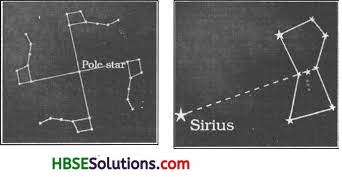
Question 11.
Name two objects other than planets which are members of the solar system.
Answer:
Meteors and Asteroids.
Question 12.
Explain how you can locate the Pole Star with the help of Ursa Major.
Answer:
Pole star is situated at the end of the Ursa Major. If a straight line starting from the last two stars is extended towards the north direction, it will lead to the Pole Star.
Question 13.
Do all the stars in the sky move? Explain.
Answer:
All the stars in the sky do not move, but they appear to move from east to west. This is actually due to rotation of earth on its axis. Earth moves from west to east. So it appears as the stars are rising from east and as the day dawns they sets in the west.
Question 14.
Why is the distance between stars expressed in light years? What do you understand by the statement that a star is eight light years away from the earth?
Answer:
Stars are away from the earth millions of kilometres away. It is not convenient to express such a large distance in the units of km. So the distance of stars from the earth is expressed in time taken by light to travel in one year. Eight light years mean time taken by light to travel in eight years.
Question 15.
Boojho made the following sketch (figure) of the solar system. Is the sketch correct? If not, correct it.
Answer:
No, the sketch is incorrect. The following sketch is correct.
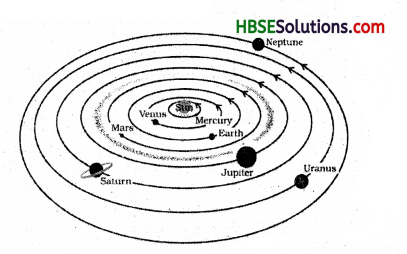
Extended Learning – Activities and Projects
Question 1.
If possible, visit a planetarium. There are planetariums in many cities. In a planetarium you can see the motion of the stars, constellations and planets on a large dome.
Answer:
For self attempt.
Question 2.
On a moonless night observe the sky for a few hours. Look out for a meteor, which appears as a streak of light. September-November is a good time for observing meteors.
Answer:
For self attempt.
Question 3.
Learn to identify the planets visible to the naked eye and some prominent constellations such as Great Bear (Saptarshi) and Orion. Also try to locate the Pole Star and the star Sirius.
Answer:
For self attempt.
Question 4.
Select a convenient place on the roof of your house or in some playground from where you can watch sunrise clearly. Remember that you will have to do this activity for a few months. So, choose the place carefully. On a sheet of chart paper draw the outline of the eastern horizon indicating big trees, poles, etc. Mark the outline of the sheet so that you can place it in the same position every time. After every two weeks, note the position from where the Sun rises and mark this on your chart paper (Fig.). Also note the date of your observation. Repeat this for a few months. It is advisable that you start observations in the month of November or May.

Does the Sun always rise from the same direction? Discuss your observations with you teacher, parents and elderly people in your family or in the neighbourhood.
Answer:
For self attempt.
Question 5.
Form a group of studens. Prepare a model of the solar system showing the planets, and their relative sizes. For this take a large chart paper. Make spheres representing different planets according in their relative size (Use Table). You may use newspaper, clay or plasticine to make spheres. You can cover these spheres with paper of different colours. Exhibit your model in the class.
| Name of Planet | Approximate radius (assuming Earth as 1 unit) | Approximate distance from the Sun (Assuming distance of the Earth as 1 unit) | Period of revolution | Period of rotation |
| Mercury | 0.40 | 0.39 | 88 days | 59 days |
| Venus | 0.95 | 0.72 | 225 days | 243 days |
| Earth | 1.00 | 1.00 | 365.25 days | 24 hours |
| Mars | 0.55 | 1.50 | 687 days 24 hours | 37 min |
| Jupiter | 11.00 | 5.20 | 12 years 9 hours | 55 min |
| Saturn | 9.00 | 9.50 | 29.46 years | 10.66 hours |
| Uranus | 4.00 | 19.20 | 84 years | 17.2 hours |
| Neptune | 3.90 | 30.00 | 165 years | 16.1 hours |
Answer:
For self attempt.
Question 6.
Try to make a scale model of the solar system showing distances of the planets from the Sun (Use Table 17.1). Did you face any difficulty? Explain it.
Answer:
For self attempt.
![]()
Question 7.
Solve the following riddle and try to make similar riddles yourself:
My first is in VAN but not in PAN
My second is in EARTH and also in HEAVEN
My third is in ONE and not in TWO
My fourth is in BUN and also in FUN
My last is in STAR but not in RADAR
I am a planet that moves round the Sun.
You can read more on the following websites:
→ http://www.nineplanets.org
→ http://www.kidsastronomy.com
→ http://www.solarsystem.nasa.gov/planets
→ http://aa.usno.navy.mil/fazz/does/moon- phases.html
Answer:
For self attempt.
HBSE 7th Class Science Stars and the Solar System Important Questions and Answers
Very Short Answer Type Questions
Question 1.
Name any three celestial bodies.
Answer:
Stars, Satellite, Planets.
Question 2.
Name the planets of solar system which cannot be seen by naked eye?
Answer:
Neptune and Pluto.
Question 3.
Name the force which makes planets move around the sun.
Answer:
Gravitational force.
Question 4.
Which has higher density : Earth or Sun?
Answer:
Earth.
Question 5.
Name the planet narest to earth.
Answer:
Mars is nearest to earth.
Question 6.
Write the names of any two constellation.
Answer:
Great Bear and Orion.
Question 7.
A group of stars visible in winter season look like a cluster of twinkling gems.
Answer:
Pleiades constellation.
Question 8.
In which season of the year are the constellations scorpio and orion visible in the Northern Hemisphere?
Answer:
Orion – Winters.
Scorpio – Summers.
Question 9.
Define star.
Answer:
Stars are the heavenly bodies that are extremely hot and have light of their own.
Question 10.
Name the star which is nearest to the earth.
Answer:
Alpha Centuari.
Question 11.
Write the names of two planets which are closer to the sun than the earth.
Answer:
Mercury and Venus.
Question 12.
Name the planet nearst to the sun.
Answer:
Mercury.
Question 13.
Name the planet farthest from the sun.
Answer:
Neptune.
Question 14.
Which planet of the solar system is the hotest?
Answer:
Mercury.
Question 15.
Name the planet of the solar system Which is nearer to the Sun and Venus.
Answer:
Mercury.
![]()
Question 16.
Which planet in the solar system is nearest to the earth?
Answer:
Venus.
Question 17.
Name the planet, where there is no carbon dioxide.
Answer:
Mercury.
Question 18.
Name the planets, which has no moon?
Answer:
Mercury and Venus.
Question 19.
Give any two applications of remote sensing.
Answer:
(i) Preparing waste land maps.
(ii) Survey for ground water and mineral resources.
Question 20.
A constellation having seven prominent stars, is visible during the winter. Name the constellation.
Answer:
Orion.
Question 21.
A belt of assorted debris, which failed to assemble into a planet, is located between the orbits of two planets in the solar system. Name these two planets.
Answer:
Mars and Jupiter.
Question 22.
Which planet has rings around it?
Answer:
Saturn.
Question 23.
Name largest asteroid.
Answer:
Ceres.
Question 24.
Why do meteors shine?
Answer:
On entering earth’s atmosphere, meteors become hot and bum due to friction of earths atmosphere and start to shine.
Question 25.
What are meteorites?
Answer:
Big pieces of rock material which do not bum completely in atmosphere of earth, fall on its surface. These are called meteorites.
Question 26.
How are comets formed?
Answer:
When the path of objects near the edge of solar system is disturbed to push them near to sun, comets are formed.
Question 27.
After how much time Halley’s comet is seen?
Answer:
After every 76 years.
Question 28.
Why does pole star appear to be stationary?
Answer:
Pole star lies on the axis of rotation of earth and appears stationary when viewed from any part of earth.
![]()
Question 29.
What does the colour of a star signify?
Answer:
Colour of a star signifies its temperature.
Question 30.
Define a satellite.
Answer:
A satellite is a solid heavenly small sized body revolving round a planet.
Short Answer Type Questions
Question 1.
Distinguish between stars and planets.
Answer:
| Star | Planet |
| (i) Star has its own light. | (i) Planet does not have its own light. |
| (ii) Star seems to move from east to west in the sky. | (ii) Planet moves around a star called sun. |
| (iii) Stars are very big and gaseous in nature. | (iii) Plants are comparatively small but appear big because they are nearer to earth. |
Question 2.
Explain the importance of stars for the people in ancient times.
Answer:
In ancient times when there were no compass, night sky was very useful in finding the direction. As pole star remains fix in the sky in north, it indicated north direction. As the stars change their position with time, it has been possible to find the time with relative position of stars.
Question 3.
How is the pole star located in the sky? Why is it so special?
Answer:
The earth rotates on its axis from west to east, therefore, the stars appear to move in opposite direction, i.e. east to west. But pole star lies on the axis of rotation of earth which is fixed, Therefore, pole star also seems to be fixed in the sky. It is always in north direction and is very useful for finding direction.
Question 4.
Distinguish between star and shooting star.
Answer:
| Star | Shooting star |
| (i) It has its own light. | (i) It produces light when it becomes hot after entering in earth’s atmosphere. |
| (ii) Star is a gaseous body. | (ii) It is not a star at all and is made of rocky material. |
| (iii) Has a very long life. | (iii) Lasts only for a very short time. |
Question 5.
What is a meteor? Why does it last for a very short time?
Answer:
Meteors are the heavenly bodies made of rocky material which enter earth’s atmosphere. When they travel through air they become hot and burn because of friction. Due to this, these rocky pieces melt and vaporises very fast and do not last long.
Question 6.
Distinguish between natural and artificial satellites.
Answer:
Natural satellites are far away from planets. They are comparatively larger in size and are present naturally. Artificial satellites are sent from earth with specific requirements. Their distanc, size and mass are lesser than the natural satellite.
Question 7.
What is solar system? Name the planets situated between the sun and the earth?
Answer:
The solar system consists of the sun, eight planets; and their satellites and other heavenly bodies like meteors, comets and asteroids. The sun is the centre of the solar system and all the planets revolve around the sun in elliptical paths called orbits. The planets situated between the sun and the earth are Mercury and Venus.
Question 8.
What are the phases of the Moon?
Answer:
Moon has no light of its own. It reflects light of the Sun falling on it. On new moon day, moon is between the sun and the earth and no reflected light from it reaches the earth. We cannot see moon on that day. The visible moon increases every day till fifteenth day from the new moon day, the full phase of the moon is visible.
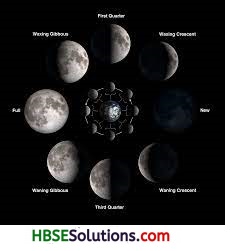
Positions of the Moon in its orbit and its corresponding phases
So, the waxing and waning of moon periodically as it revolves around the earth is called phases of moon.
Question 9.
Why moon cannot be used as a communication satellite?
Answer:
Moon is a natural satellite of the earth but it cannot be used as a communication satellite because :
- It is very far away from earth.
- Its time period 27.3 days is too large.
- It has neither equitorial orbit nor polar orbit which makes a satellite useful for different purposes.
![]()
Question 10.
What are constellations? Name some easily recognizible constellations in the sky.
Answer:
Group of stars forming a recognizible shape is called a constellation. These group of stars are identified in different shapes. Constellations do not change their shape. They also appear to move from east to west as other stars appear to. Some major constellations are Ursa Major, Ursa Minor, Orion, Cassiopeia etc. Some of them are visible during summers while some are visible during winters.
Question 11.
What are various types of motions associated with the planet earth?
Answer:
The earth has four types of motion. These are :
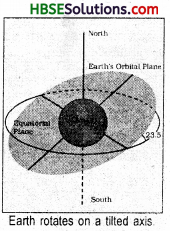
(i) The earth’s daily rotation on its axis.
(ii) The earth’s annual revolution around the sun.
(iii) The earth’s precession (conical motion of earth’s axis).
(iv) As a part of solar system, the earth’s motion in space along with the sun.
Question 12.
Explain the constellation Ursa Major.
Answer:
Ursa Major is one of the most famous constellation. We can see this constellation during summers. It is also called the Great Bear or the Saptarishi. There are seven prominently shining stars in this constellation which are arranged in shape of a question mark. At the tail of this constellation lies the Pole Star.
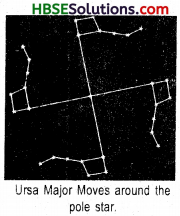
Question 13.
Describe the constellation also called the hunt.
Answer:
A well known constellation named Orion is also called the hunter. This constellation can be seen in the late evenings of winter. It has seven or eight brightly shining stars arranged in shape recognized with hunter. The brightest star in the sky Sirius is located at the extended line from the tail of this constellation.
Question 14.
What are asteroids?
Answer:
Asteroids are the small objects which revolve around the sun in a large gap between the orbits of Mars and Jupiter. These are quite large in their number and are considered as the part of our solar system. Each asteroid has its own orbit.
Question 15.
What are comets?
Answer:
Comets are the part of our solar system which revolve around the sun in highly elliptical orbits. It appears with a bright head and a long tail. The length of the tail grows in size as it approaches the sun. The tail is always directed away from sun.
Question 16.
What are various superstitions connected with appearance of comets?
Answer:
They are considered to be the messangers of destruction and disasters. They are supposed to bring wars,epidemics and flood with them. So, their appearance is considered as unauspicious.
![]()
Question 17.
List five uses of artificial satellites.
Answer:
- Weather forecasting.
- Radio and television transmission.
- Long distance communication.
- Locating mineral resources.
- Gathering information about our space.
Long Answer Type Questions
Question 1.
Explain celestial sphere.
Answer:
The large imaginary sphere on which all the heavenly bodies like stars, planets and satellites seems to lie is known as celestial sphere. Since we are on the earth, the earth appears stationary to us. When we look at the sky, the various objects in the sky like the stars and the moon appear to be moving round the earth. In other words, the celestial sphere appears to be moving from east to west round the earth. This apparent motion of the celestial sphere from east to west is actually due to the daily rotation of the earth from west to east. Since the earth rotates from west to east, the celestial sphere appears to rotate in the opposite direction, from east to west.
Question 2.
What are constellations? Explain. Name some prominent constellations with their Indian names.
Answer:
The groups of stars which seem to be arranged in the sky in beautiful patterns and recogniseable shapes are known as constellations. With each constellation, the ancient astronomers assigned the name of an object which it appears to resemble. There are 88 constellations into which the whole of the sky has been divided. In Indian astronomy, the constellations are known as Nakshatras.
Some prominent constellations with their Indian names are given below :
(i) Ursa Major or Saptarishi.
(ii) Ursa Minor or Laghu Saptarishi
(iii) Orion or Mriga or Vyadha
(iv) Tarus or Vrashba
(v) Scorpio or Vrishchika.
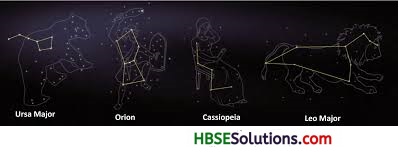
Question 3.
What is pole star? What is specific j about its position in the sky?
Answer:
There is only one star in the sky which appears stationary to an observer on earth. This star is named as pole star (Polaris) or Dhruvtara in India. This star appears stationary because, i it lies in the direction of the axis of the Earth about which the earth rotates. Any point on or j along the axis of a rotating body appears to be stationary. So, the pole star that lies along the direction of the axis of rotation of the earth, always sppears to be stationary.
Question 4.
What are artificial satellites? Explain their usage.
Answer:
Man made objects orbitting in outer space around the earth or any other planet are called artificial satellites of earth or that particular planet. The satellite like INSAT 3E or Kalpana Chawla I are examples of artificial satellites. Artificial satellites have many practical applications that effect our lives in many ways, i Long distance transmission of television programmes, communication through telephones and internet could be possible because of them. Artificial satellites are also used for research, defence and remote sensing. Remote sensing means collecting information from a distance. Information is collected regarding weather, agriculture, land and ocean features including movement of fish.
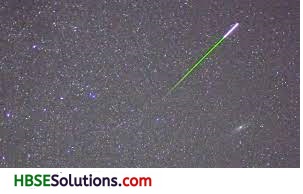
Stars and the Solar System Class 8 HBSE Notes
- We can see many celestial bodies in a clear night sky.
- Stars are one of the celestial bodies which emit light of their own.
- Sun is also one of the stars which emits light and is a great source of heat. It is the closest star which is the centre of our solar system.
- Stars are many light years away from the earth and thus look very small from earth.
- Stars appear to travel from east to west.
- Pole star is the most shining star in the night sky. The pole star appears to.be stationary. It is situated near axis of rotation of earth and is thus helpful in finding direction.
- A group of stars, appearing in different shapes are called constellations. Their shapes resemble different objects and thus are named after the names of the objects.
- Other improtant parts of night sky are the planets. Planets are those celestial bodies, which revolve around sun.
- Our solar system consists of eight planets revolving around sun. It also consists of many other celestial bodies like asteroids, comets and meteors.
- Comets are the celestial bodies that revolve in highly elliptical orbits around sun.
- Bright streak of light in a night sky are commonly called shooting stars or meteors.
- A celestial body revolving around another celestial body is called a satellite.
- Artificially sent bodies in space, which revolve around earth or any other planet or a natural satellite is called an artificial satellite
- Jupiter is the largest planet while Venus is brightest planet in the night sky.
- Moon is the natural satellite of the earth. Moon appears in different phases. The phases of Moon occur because we can see only that part of the moon which reflects light towards us.